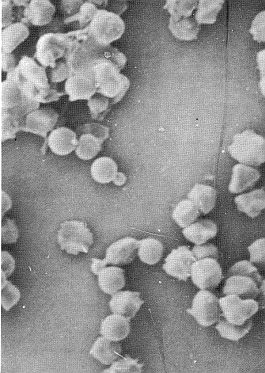 Stapylococus: género de bacterias perteneciente a la familia de las Micrococcaceae, gram positivos, no esporulados, aerobios facultativos, inmóviles. Su nombre, que en griego significa racimo de granos, deriva del hecho de que este germen tiende a agruparse en masas desordenadas que recuerdan los racimos de uva, si bien también se pueden encontrar como elementos únicos o en pares, en grupos de cuatro o en cadenas cortas de tres o cuatro células. Se han identificado unos 30 serotipos. Presentan una gran variedad de enzimas, toxinas, hemolisinas y componentes celulares. Entre los factores de virulencia de estas bacterias está su actividad coagulasa, siendo mayor la virulencia cuanto mayor actividad coagulasa tenga. Casi todas las inflamaciones del cuerpo están asociadas con este germen. Cerca del 80% son resistentes a la penicilina. Este género de bacterias comprende numerosas especies: albus, anaerobius, aureus, epidermis, etc.
Stapylococus: género de bacterias perteneciente a la familia de las Micrococcaceae, gram positivos, no esporulados, aerobios facultativos, inmóviles. Su nombre, que en griego significa racimo de granos, deriva del hecho de que este germen tiende a agruparse en masas desordenadas que recuerdan los racimos de uva, si bien también se pueden encontrar como elementos únicos o en pares, en grupos de cuatro o en cadenas cortas de tres o cuatro células. Se han identificado unos 30 serotipos. Presentan una gran variedad de enzimas, toxinas, hemolisinas y componentes celulares. Entre los factores de virulencia de estas bacterias está su actividad coagulasa, siendo mayor la virulencia cuanto mayor actividad coagulasa tenga. Casi todas las inflamaciones del cuerpo están asociadas con este germen. Cerca del 80% son resistentes a la penicilina. Este género de bacterias comprende numerosas especies: albus, anaerobius, aureus, epidermis, etc.
<(A.): Staphylokokken: sind grampositive, kugelförmige Bakterien, die in mikroskopisch kleinen, traubenähnlichen Büscheln vorkommen. Die bakteriologische Kultur der Nase und der Haut des normalen Menschen ergibt unweigerlich Staphylokokken. 1884 beschrieb Rosenbach die beiden pigmentierten Kolonie-Typen der Staphylokokken und schlug die entsprechende Nomenklatur vor: Staphylococcus aureus (gelb) und Staphylococcus albus (weiß). Die letztere Art wird nun Staphylococcus epidermidis genannt. Obwohl im Bergey-Handbuch (2001) mehr als 20 Staphylococcus-Arten beschrieben sind, sind nur Staphylococcus aureus und Staphylococcus epidermidis in ihren Interaktionen mit dem Menschen von Bedeutung. S. aureus kolonisiert hauptsächlich die Nasenwege, kann aber auch in den meisten anderen anatomischen Lokalisationen, einschließlich der Haut, der Mundhöhle und des Gastrointestinaltraktes, regelmäßig gefunden werden. S. epidermidis ist ein Bewohner der Haut.
<(F.): Staphylococcus: genre bactérien de la famille des Micrococcaceæ (les staphylocoques) de forme arrondie (coccus), Gram+ non sporulés, catalase+, immobiles, caractérisées par leur groupement rappelant celui des grains d'une grappe de raisin. Il comprend plusieurs espèces que l'on distingue d'après la coloration de leur culture sur agar (Staphylococcus aureus, albus, citreus, doré, blanc, citrin). M Staphylococcus epidermidis : staphylocoque blanc, S. saprophyticus.
<(In.): Staphylococcus: are Gram-positive spherical bacteria that occur in microscopic clusters resembling grapes. Bacteriological culture of the nose and skin of normal humans invariably yields staphylococci. In 1884, Rosenbach described the two pigmented colony types of staphylococci and proposed the appropriate nomenclature: Staphylococcus aureus (yellow) and Staphylococcus albus (white). The latter species is now named Staphylococcus epidermidis. Although more than 20 species of Staphylococcus are described in Bergey's Manual (2001), only Staphylococcus aureus and Staphylococcus epidermidis are significant in their interactions with humans. S. aureus colonizes mainly the nasal passages, but it may be found regularly in most other anatomical locales, including the skin, oral cavity and gastrointestinal tract. S epidermidis is an inhabitant of the skin.
FUENTES DE INFORMACIÓN BIOMÉDICA:
-
CISMeF.<(F)
-
Scientific Electronic Library Online.<(E) - <(P) - <(Ing)
INFORMACIÓN PACIENTES:
-
MEDLINE PLUS. <(E)
METICILINRESISTENTE:
-
ESTADO DE NEW YORK. <(E)
TRANSMISION:
VACUNA:
-
GRANMA CUBA. <(E)
TÉRMINOS RELACIONADOS:
